Aponogeton longiplumulosus
Scientific name: Aponogeton longiplumulosus
Family: Aponogetonaceae
Maximum size reached under cultivation: 35 - 60 cm (13.78 - 23.62 inch)
014
Recommended pH range: 5.7 - 7.9
Recommended water hardness: 0 - 12°dGH (0 - 214.29ppm)
0°C 32°F30°C 86°F
Recommended temperature range: 18 - 26 °C (64.4 - 78.8°F)
Preferred propagation method: Seeds
Native to: Madagascar
Growth rate: Normal
Recommended substrate: Fine gravel
Lighting requirements: Bright
Ideal placement in tank: Background
🌿 Family
Aponogetonaceae
🏷️ Common Name
Long-plumed Aponogeton
🌍 Origin
Aponogeton longiplumulosus is endemic to Madagascar, where it naturally grows in slow-moving rivers and freshwater lakes. In the wild, it remains fully submerged year-round, making it well-adapted to aquarium conditions.
📍 Planting Area
This species is best placed in the background of aquariums due to its long, flowing leaves that can grow between 35 to 60 cm (13.78–23.62 inches). It adds height, texture, and movement to aquascapes.
💡 Lighting Requirements
Moderate to bright lighting is essential for optimal growth. A minimum of 0.5 watts per liter (or appropriate LED lighting) supports strong foliage development. Intense light enhances leaf color, but monitor algae. Ideal photoperiod: 8–10 hours per day.
🌱 Propagation
Aponogeton longiplumulosus reproduces primarily through tuber division. While it may flower and produce seeds in aquariums, vegetative propagation is more reliable. Allow tubers to develop several shoots, then gently separate and replant healthy divisions. A brief dormant phase may occur after flowering.
🧪 Difficulty
Moderate care level. This species requires stable water conditions, consistent fertilization, and root nutrient support. Its slow growth and periodic dormancy may confuse less experienced aquarists, but it rewards patience with beauty and longevity.
📝 Short Description
Aponogeton longiplumulosus is a stunning aquatic plant recognized for its ruffled, lance-shaped leaves in shades of deep green or reddish-brown. It grows slowly but makes a dramatic statement in larger, well-lit freshwater tanks. It thrives in soft to moderately hard water, at temperatures of 18–26 °C (64.4–78.8 °F), and prefers a fine gravel substrate enriched with nutrients.
🧷 Additional Care Tips
Use root tabs or nutrient-rich substrates to nourish the tuber. During dormancy, avoid moving or disturbing the tuber. Growth typically resumes within a few weeks when conditions remain stable.
❓ Frequently Asked Questions (FAQ)
- 🌬️ Can it grow without CO2?
Yes, CO2 is not required, but adding it improves leaf size, color, and overall health. - 📏 Is it suitable for small tanks?
Not ideal. Due to its large size and leaf spread, it’s best for medium to large aquariums (100 liters). - ⏳ What should I do during dormancy?
Reduce lighting and avoid disturbing the tuber. Maintain water quality, and once new growth appears, resume standard care.

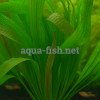 Aponogeton bovianus
Aponogeton bovianus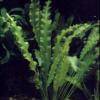 Aponogeton crispus
Aponogeton crispus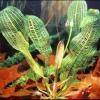 Aponogeton madagascariensis
Aponogeton madagascariensis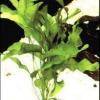 Aponogeton natans
Aponogeton natans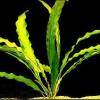 Aponogeton rigidifolius
Aponogeton rigidifolius Aponogeton ulvaceus
Aponogeton ulvaceus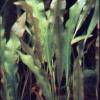 Aponogeton undulatus
Aponogeton undulatus